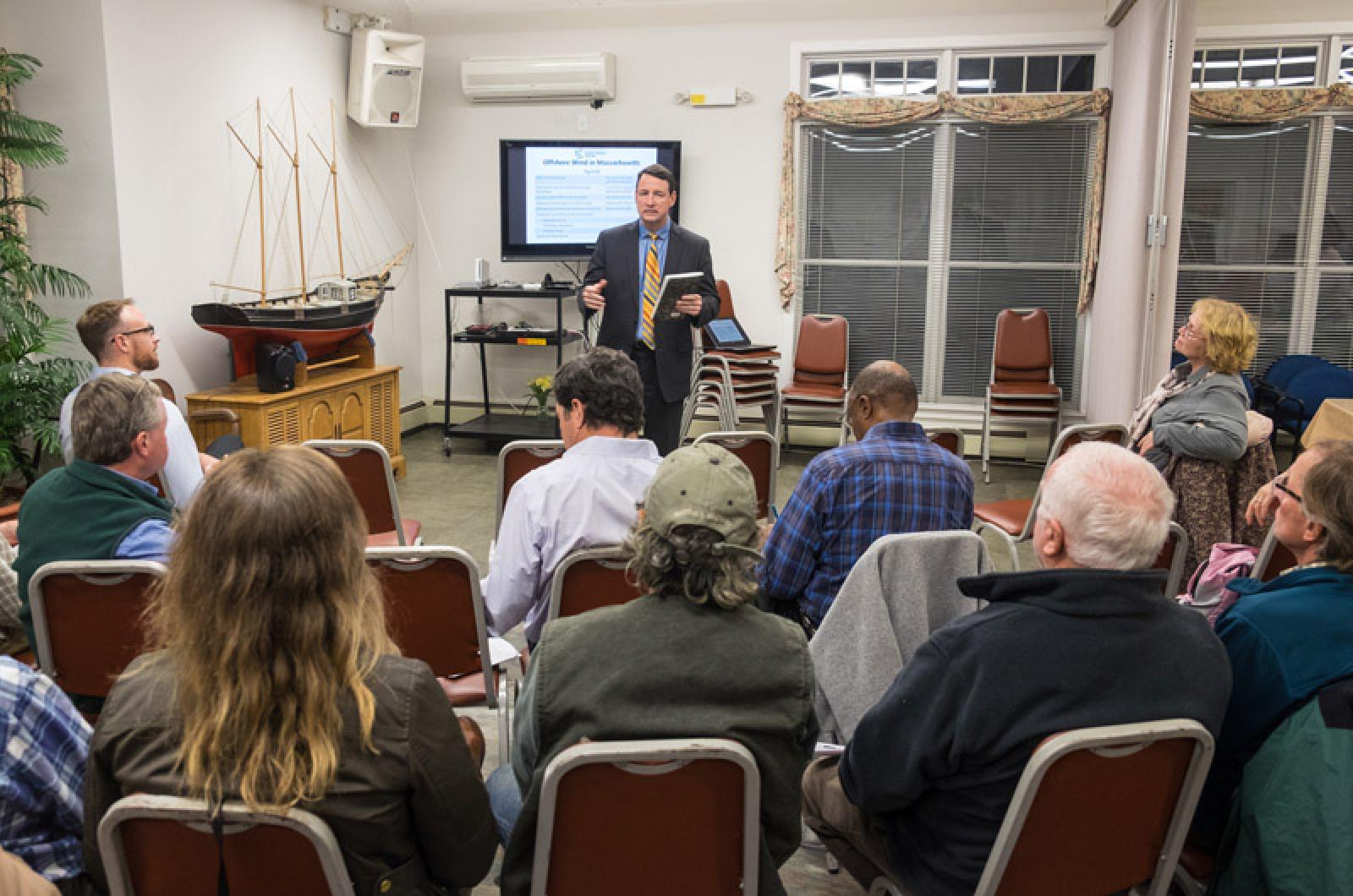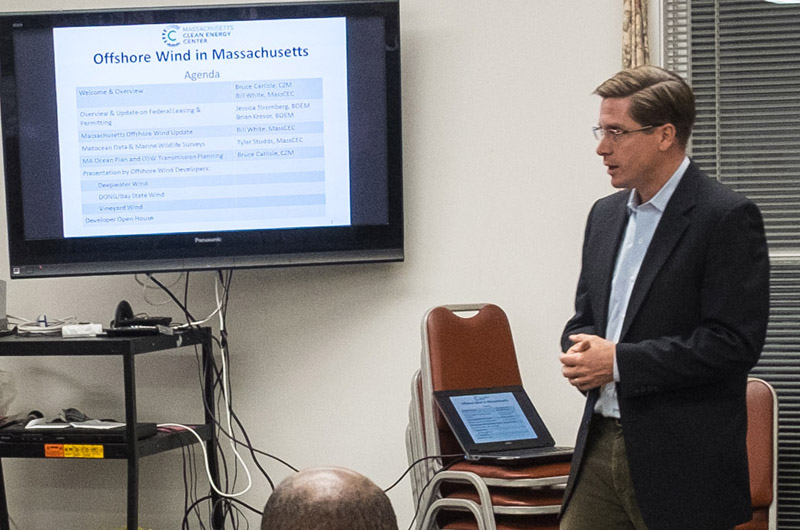With offshore wind developers inching their way through the federal permitting process, government and company representatives stopped by the Vineyard this week to gather feedback and provide an update on their work.
Representatives from the federal Bureau of Ocean Energy Management (BOEM), which regulates offshore wind projects in the U.S., gave an overview of the permitting process, which involves years of surveys and analysis for each site. And members of the Massachusetts Clean Energy Center (MassCEC) spoke about new energy legislation in the state and efforts to mitigate the effects of wind turbines on marine species.
The Danish company Dong Energy this year obtained a lease on a large area of federal waters south of the Vineyard, as did a partnership between OffshoreMW (owned by the Danish company Copenhagen Infrastructure Partners) and Vineyard Power, the Island energy cooperative. Deepwater Wind, with financial backing from the D.E. Shaw Group of New York, is pursuing a project off Rhode Island.
Dong has already completed initial surveys of the ocean floor. The Vineyard Power partnership plans to make its final passes with a survey vessel this week.
The two projects are now billed as Bay State Wind and Vineyard Wind, respectively.
Bruce Carlisle, director of the state office of Coastal Zone Management, which along with MassCEC organized the event at the Tisbury Senior Center on Monday, said one goal was to keep the public engaged in the process. A series of upbeat presentations were peppered by comments from Island residents, some of whom expressed frustration over a process they felt was out of their control.
Tisbury selectman Tristan Israel praised the work of the federal agency, but pressed for more local involvement, noting a renewable energy task force that had included several Islanders and helped refine the federal wind energy area first proposed in 2009.
“You guys are doing great,” Mr. Israel said. “But I’m a little disappointed that the task force has kind of been blown off.” Bill White, director for offshore wind at MassCEC, and Jessica Stromberg, project coordinator at BOEM, were open to his suggestion that the group reconvene in the near future.
The Island stopover came against a backdrop of new legislation in Massachusetts that requires utilities to sign contracts for up to 1,600 megawatts of offshore wind energy over the next 10 years. Mr. White noted the expected closures of coal-fired power plants in the region, and said offshore wind could power a third of all homes in the state. He also noted the well-established offshore wind industry in Europe. “This is not a new technology,” he said. “They have been making all the mistakes so that we don’t have to.”
He cited projections that 1,600 megawatts of wind power could offset 2.4 million tons of greenhouse gas emissions per year, or up to 11 per cent of the state’s total energy consumption, helping to mitigate climate change.
BOEM has collected a large amount of data related to whales, birds and sea turtles, which could help mitigate the harmful effects of offshore development in the region. About 60 endangered right wales have been spotted from the air since 2011, which will help create a baseline for further study, said Tyler Studds, senior manager of renewable energy strategy for MassCEC.
The state is also working with the Woods Hole Oceanographic Institution to measure wind speeds at various heights above the water. An observation tower about a mile off South Beach allows scientists to measure wind speeds at heights of up to 200 feet, which Mr. Studds said could provide data to help developers refine their bids with utilities next year. (The first bids are due by June 30.)
Getting the energy ashore will require miles of undersea cables, and port facilities that can handle heavy infrastructure. Building and maintaining the wind farms is expected to generate a large number of temporary jobs in the region. Mr. Israel said he hoped to see the Island benefit as well. The Vineyard Power project includes a community benefits agreement that could help jobs stay on the Island.
Chilmark selectman Warren Doty suggested that since construction is still well in the future, the state could help fund vocational programs for high school students to learn the relevant trades. “These are going to be high-value jobs,” he said, adding that schools would likely be unable to handle the costs themselves.
“We hear that loud and clear,” said Mr. White, who said he sees that type of training as an opportunity for the state as it works to kickstart the offshore wind industry.
Mr. Carlisle spoke in more detail about the issue of connecting offshore wind energy to the grid, although he said it is somewhat uncharted territory for his agency, which focuses on coastal resource protection. He pointed to a number of substations where the cables could come ashore, including at Brayton Point and West Barnstable.
“This is a work in progress,” he said.
Peter Cabana, a civil engineer and Island resident, pressed for a clearer outlook. “Why hasn’t anyone looked at where this stuff is going to go?” he said, recalling discussions with government officials some time ago that he said also left the question unanswered. Mr. Carlisle said an answer would depend at least partly on guidance from stakeholders. Dong Energy has already decided to bring its cables ashore at Brayton Point.
Representatives from the three companies provided short updates on their work so far, which has depended in large part on the cooperation of commercial fishermen who share the waters. Dong Energy saw a cool reception from Vineyard fishermen during a visit to the Island last year. The company worked with John Williamson, a fisherman from Maine, to help coordinate the surveys this year, and with Steve Welch, a fisherman from Plymouth, who accompanied the crew on its survey vessels. Vineyard Power worked with New Bedford fisherman Jim Kendall, who distributed computer thumb drives that allowed fishermen to see the survey area overlaid on their navigation charts.
Paul McDonald, a fisherman out of Menemsha, complained that Dong Energy had failed at least once to respond to his efforts to hail the survey vessel, and he worried that the addition of turbines would only complicate matters in the future. “We need to figure this out now,” he said. Mr. Carlisle assured him that various groups were working to get everyone on the same page. But that was also a work in progress. “We may need to reassess how we are doing that,” Mr. Carlisle said.
Links to the federal reports on marine species are available on the Martha’s Vineyard Commission website, mvcommission.org.








Comments (11)
Comments
Comment policy »